Financial Management Report: NPV Analysis for Hamilton Inc. Project
VerifiedAdded on 2023/01/12
|13
|3851
|57
Report
AI Summary
This report delves into financial management principles, particularly focusing on Net Present Value (NPV) and investment appraisal techniques. It uses a case study of Hamilton Inc., a sports equipment manufacturer, to illustrate the application of NPV in evaluating capital investment projects, specifically the replacement of manufacturing machinery. The report calculates and compares the NPV of two proposals: continuing with existing equipment versus investing in new machinery. It provides detailed calculations, working notes, and recommendations for Hamilton Inc., considering factors like cash flows, discount rates, and initial investments. Furthermore, the report critically discusses the use of NPV as an investment appraisal method, outlining its advantages and disadvantages, and suggesting alternative appraisal techniques. The report is a valuable resource for students studying financial management and investment analysis. The report also stresses the importance of brand value and equity for Hamilton Inc. It further recommends that the company should not rely on just one investment appraisal technique like NPV and should also use other techniques like payback period, internal rate of return and annual rate of return to arrive at a more informed decision.

Financial management
Paraphrase This Document
Need a fresh take? Get an instant paraphrase of this document with our AI Paraphraser

Contents
INTRODUCTION...........................................................................................................................1
Calculating the net present value.................................................................................................1
Explaining which project should be accepted.............................................................................4
Recommendations........................................................................................................................5
Critically discussing the use of net present value as a method of investment appraisal..............6
Use of alternative approaches to capital investment appraisal....................................................9
CONCLUSION..............................................................................................................................10
REFERENCES..............................................................................................................................11
INTRODUCTION...........................................................................................................................1
Calculating the net present value.................................................................................................1
Explaining which project should be accepted.............................................................................4
Recommendations........................................................................................................................5
Critically discussing the use of net present value as a method of investment appraisal..............6
Use of alternative approaches to capital investment appraisal....................................................9
CONCLUSION..............................................................................................................................10
REFERENCES..............................................................................................................................11

INTRODUCTION
Financial management is the procedure of managing the financial resources, recording and
presentation of an organisation which can assist in procedure of decision making. The concept of
financial management is said to be used in three parameters which are investment decision,
financing decision and dividend decision (Altman and et.al., 2017). The main aim of this report
is to develop an understanding about the concepts of quantitative and qualitative accounting
information in an organisation. For this purpose, an organisation is selected which is Hamilton
Inc. This organisation is a sports equipment manufacturer which is located in USA. This
company is a growing organisation and continuously advancing their technologies. This
company is considering purchase of a new machinery and for this proposal technique of NPV is
used in order to analyse its viability.
In this report, financial analysis will be conducted in which net present value of both the
proposals will be evaluated along with a detailed explanation. Further, this report will cover
recommendations for this company which will be based on NPV computation. At last, the
investment appraisal technique of net present value will be analysed along with few alternative
approaches of net present value.
QUESTION 1
Calculating the net present value
Hamilton Inc. is an organisation which manufacture sports equipment. This company is
considering replacing one of their basketball manufacturing machinery (MA02) with an
advanced machinery (MA05). It is believed that MA05 will produce higher quality basketballs
which will result in increase in sales.
There are total of two proposals which Hamilton Inc. is considering. The first proposal
states that company will continue the use of MA02 till 2020 and then sell it with the residual
value of $80,000. The Second proposal states that the company will replace MA02 with MA05
in which MA05 will be acquired for $ 1.7 million and MA02 will immediately sold for $100,000
and after three years MA05 will also be sold for $200,000. Considering determinants for both the
proposals and inflation rates. The NPV for both the projects are computed below along with
extensive working notes:
1
Financial management is the procedure of managing the financial resources, recording and
presentation of an organisation which can assist in procedure of decision making. The concept of
financial management is said to be used in three parameters which are investment decision,
financing decision and dividend decision (Altman and et.al., 2017). The main aim of this report
is to develop an understanding about the concepts of quantitative and qualitative accounting
information in an organisation. For this purpose, an organisation is selected which is Hamilton
Inc. This organisation is a sports equipment manufacturer which is located in USA. This
company is a growing organisation and continuously advancing their technologies. This
company is considering purchase of a new machinery and for this proposal technique of NPV is
used in order to analyse its viability.
In this report, financial analysis will be conducted in which net present value of both the
proposals will be evaluated along with a detailed explanation. Further, this report will cover
recommendations for this company which will be based on NPV computation. At last, the
investment appraisal technique of net present value will be analysed along with few alternative
approaches of net present value.
QUESTION 1
Calculating the net present value
Hamilton Inc. is an organisation which manufacture sports equipment. This company is
considering replacing one of their basketball manufacturing machinery (MA02) with an
advanced machinery (MA05). It is believed that MA05 will produce higher quality basketballs
which will result in increase in sales.
There are total of two proposals which Hamilton Inc. is considering. The first proposal
states that company will continue the use of MA02 till 2020 and then sell it with the residual
value of $80,000. The Second proposal states that the company will replace MA02 with MA05
in which MA05 will be acquired for $ 1.7 million and MA02 will immediately sold for $100,000
and after three years MA05 will also be sold for $200,000. Considering determinants for both the
proposals and inflation rates. The NPV for both the projects are computed below along with
extensive working notes:
1
⊘ This is a preview!⊘
Do you want full access?
Subscribe today to unlock all pages.

Trusted by 1+ million students worldwide
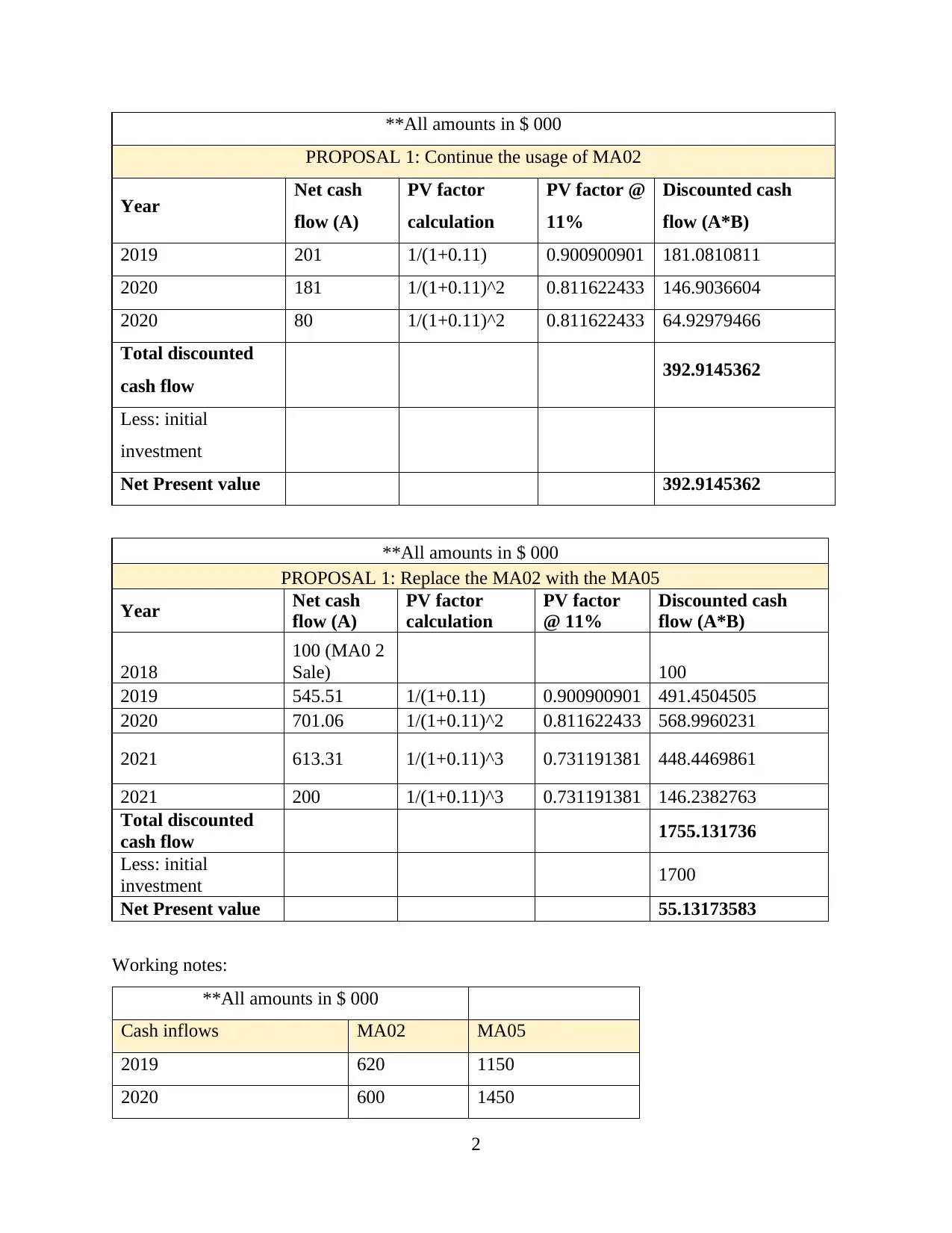
**All amounts in $ 000
PROPOSAL 1: Continue the usage of MA02
Year Net cash
flow (A)
PV factor
calculation
PV factor @
11%
Discounted cash
flow (A*B)
2019 201 1/(1+0.11) 0.900900901 181.0810811
2020 181 1/(1+0.11)^2 0.811622433 146.9036604
2020 80 1/(1+0.11)^2 0.811622433 64.92979466
Total discounted
cash flow 392.9145362
Less: initial
investment
Net Present value 392.9145362
**All amounts in $ 000
PROPOSAL 1: Replace the MA02 with the MA05
Year Net cash
flow (A)
PV factor
calculation
PV factor
@ 11%
Discounted cash
flow (A*B)
2018
100 (MA0 2
Sale) 100
2019 545.51 1/(1+0.11) 0.900900901 491.4504505
2020 701.06 1/(1+0.11)^2 0.811622433 568.9960231
2021 613.31 1/(1+0.11)^3 0.731191381 448.4469861
2021 200 1/(1+0.11)^3 0.731191381 146.2382763
Total discounted
cash flow 1755.131736
Less: initial
investment 1700
Net Present value 55.13173583
Working notes:
**All amounts in $ 000
Cash inflows MA02 MA05
2019 620 1150
2020 600 1450
2
PROPOSAL 1: Continue the usage of MA02
Year Net cash
flow (A)
PV factor
calculation
PV factor @
11%
Discounted cash
flow (A*B)
2019 201 1/(1+0.11) 0.900900901 181.0810811
2020 181 1/(1+0.11)^2 0.811622433 146.9036604
2020 80 1/(1+0.11)^2 0.811622433 64.92979466
Total discounted
cash flow 392.9145362
Less: initial
investment
Net Present value 392.9145362
**All amounts in $ 000
PROPOSAL 1: Replace the MA02 with the MA05
Year Net cash
flow (A)
PV factor
calculation
PV factor
@ 11%
Discounted cash
flow (A*B)
2018
100 (MA0 2
Sale) 100
2019 545.51 1/(1+0.11) 0.900900901 491.4504505
2020 701.06 1/(1+0.11)^2 0.811622433 568.9960231
2021 613.31 1/(1+0.11)^3 0.731191381 448.4469861
2021 200 1/(1+0.11)^3 0.731191381 146.2382763
Total discounted
cash flow 1755.131736
Less: initial
investment 1700
Net Present value 55.13173583
Working notes:
**All amounts in $ 000
Cash inflows MA02 MA05
2019 620 1150
2020 600 1450
2
Paraphrase This Document
Need a fresh take? Get an instant paraphrase of this document with our AI Paraphraser
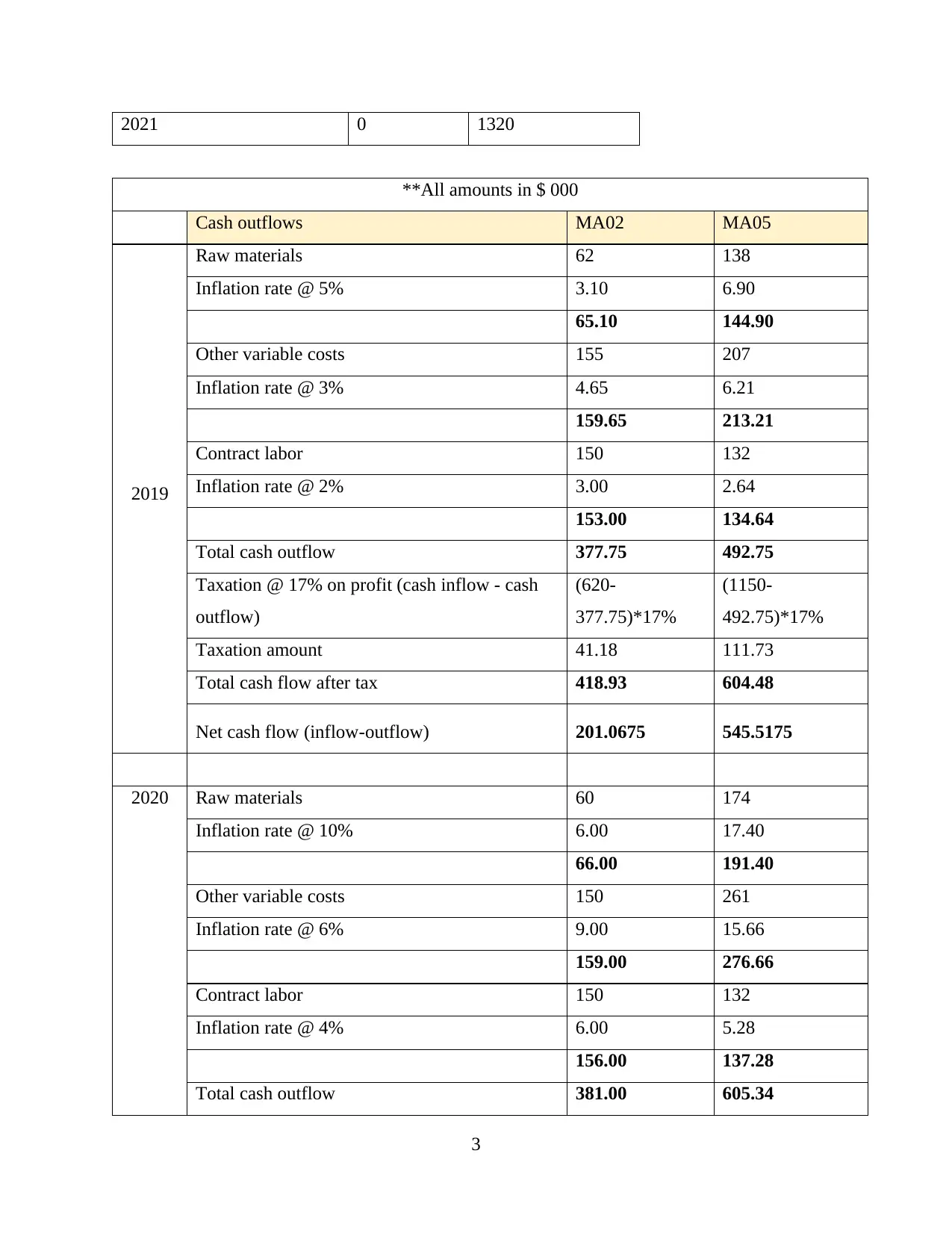
2021 0 1320
**All amounts in $ 000
Cash outflows MA02 MA05
2019
Raw materials 62 138
Inflation rate @ 5% 3.10 6.90
65.10 144.90
Other variable costs 155 207
Inflation rate @ 3% 4.65 6.21
159.65 213.21
Contract labor 150 132
Inflation rate @ 2% 3.00 2.64
153.00 134.64
Total cash outflow 377.75 492.75
Taxation @ 17% on profit (cash inflow - cash
outflow)
(620-
377.75)*17%
(1150-
492.75)*17%
Taxation amount 41.18 111.73
Total cash flow after tax 418.93 604.48
Net cash flow (inflow-outflow) 201.0675 545.5175
2020 Raw materials 60 174
Inflation rate @ 10% 6.00 17.40
66.00 191.40
Other variable costs 150 261
Inflation rate @ 6% 9.00 15.66
159.00 276.66
Contract labor 150 132
Inflation rate @ 4% 6.00 5.28
156.00 137.28
Total cash outflow 381.00 605.34
3
**All amounts in $ 000
Cash outflows MA02 MA05
2019
Raw materials 62 138
Inflation rate @ 5% 3.10 6.90
65.10 144.90
Other variable costs 155 207
Inflation rate @ 3% 4.65 6.21
159.65 213.21
Contract labor 150 132
Inflation rate @ 2% 3.00 2.64
153.00 134.64
Total cash outflow 377.75 492.75
Taxation @ 17% on profit (cash inflow - cash
outflow)
(620-
377.75)*17%
(1150-
492.75)*17%
Taxation amount 41.18 111.73
Total cash flow after tax 418.93 604.48
Net cash flow (inflow-outflow) 201.0675 545.5175
2020 Raw materials 60 174
Inflation rate @ 10% 6.00 17.40
66.00 191.40
Other variable costs 150 261
Inflation rate @ 6% 9.00 15.66
159.00 276.66
Contract labor 150 132
Inflation rate @ 4% 6.00 5.28
156.00 137.28
Total cash outflow 381.00 605.34
3

Taxation @ 17% on profit (cash inflow - cash
outflow) (600-381)*17%
(1450-
605.34)*17%
Taxation amount 37.23 143.5922
Total cash flow outflow after tax 418.23 748.93
Net cash flow (inflow-outflow) 181.7700 701.0678
2021
Raw materials 0 158
Inflation rate @ 15% 0.00 23.76
0.00 182.16
Other variable costs 0 238
Inflation rate @ 9% 0.00 21.38
0.00 258.98
Contract labor 0 132
Inflation rate @ 6% 0.00 7.92
0.00 139.92
Total cash outflow 0.00 581.06
Taxation @ 17% on profit (cash inflow - cash
outflow)
(1320-
581.06)*17%
Taxation amount 125.6198
Total cash flow after tax 706.68
Net cash flow (inflow-outflow) 613.3162
QUESTION 2
Explaining which project should be accepted
Hamilton Inc. is a growing company and it is important for them to take reliable decision
for their capital funding. This company is facing a situation where they have to either continue
the use of their existing basketball manufacturing machine or they can purchase a new improved
machinery and sell the existing one. For the effective decision making, both the proposals are
evaluated below:
4
outflow) (600-381)*17%
(1450-
605.34)*17%
Taxation amount 37.23 143.5922
Total cash flow outflow after tax 418.23 748.93
Net cash flow (inflow-outflow) 181.7700 701.0678
2021
Raw materials 0 158
Inflation rate @ 15% 0.00 23.76
0.00 182.16
Other variable costs 0 238
Inflation rate @ 9% 0.00 21.38
0.00 258.98
Contract labor 0 132
Inflation rate @ 6% 0.00 7.92
0.00 139.92
Total cash outflow 0.00 581.06
Taxation @ 17% on profit (cash inflow - cash
outflow)
(1320-
581.06)*17%
Taxation amount 125.6198
Total cash flow after tax 706.68
Net cash flow (inflow-outflow) 613.3162
QUESTION 2
Explaining which project should be accepted
Hamilton Inc. is a growing company and it is important for them to take reliable decision
for their capital funding. This company is facing a situation where they have to either continue
the use of their existing basketball manufacturing machine or they can purchase a new improved
machinery and sell the existing one. For the effective decision making, both the proposals are
evaluated below:
4
⊘ This is a preview!⊘
Do you want full access?
Subscribe today to unlock all pages.

Trusted by 1+ million students worldwide
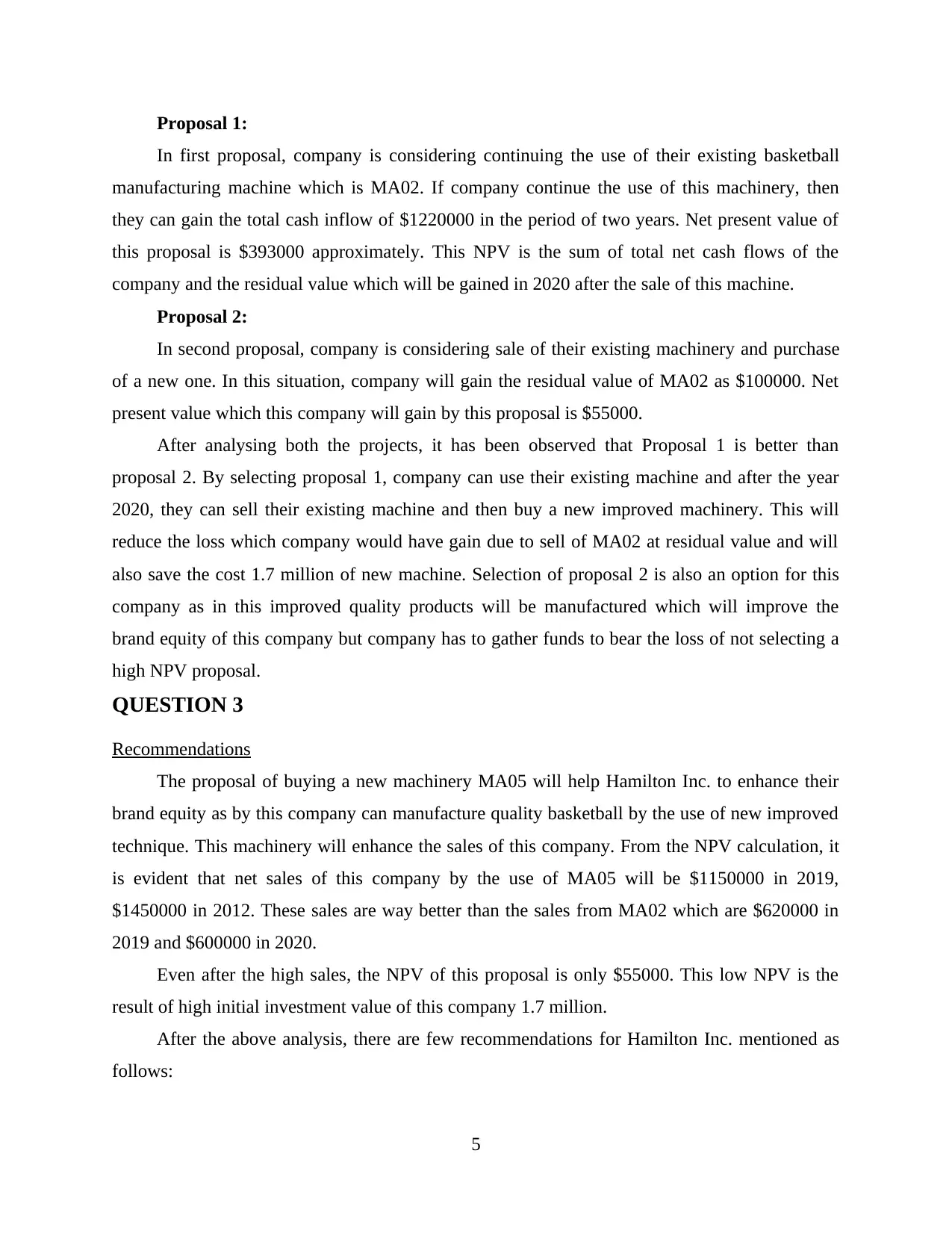
Proposal 1:
In first proposal, company is considering continuing the use of their existing basketball
manufacturing machine which is MA02. If company continue the use of this machinery, then
they can gain the total cash inflow of $1220000 in the period of two years. Net present value of
this proposal is $393000 approximately. This NPV is the sum of total net cash flows of the
company and the residual value which will be gained in 2020 after the sale of this machine.
Proposal 2:
In second proposal, company is considering sale of their existing machinery and purchase
of a new one. In this situation, company will gain the residual value of MA02 as $100000. Net
present value which this company will gain by this proposal is $55000.
After analysing both the projects, it has been observed that Proposal 1 is better than
proposal 2. By selecting proposal 1, company can use their existing machine and after the year
2020, they can sell their existing machine and then buy a new improved machinery. This will
reduce the loss which company would have gain due to sell of MA02 at residual value and will
also save the cost 1.7 million of new machine. Selection of proposal 2 is also an option for this
company as in this improved quality products will be manufactured which will improve the
brand equity of this company but company has to gather funds to bear the loss of not selecting a
high NPV proposal.
QUESTION 3
Recommendations
The proposal of buying a new machinery MA05 will help Hamilton Inc. to enhance their
brand equity as by this company can manufacture quality basketball by the use of new improved
technique. This machinery will enhance the sales of this company. From the NPV calculation, it
is evident that net sales of this company by the use of MA05 will be $1150000 in 2019,
$1450000 in 2012. These sales are way better than the sales from MA02 which are $620000 in
2019 and $600000 in 2020.
Even after the high sales, the NPV of this proposal is only $55000. This low NPV is the
result of high initial investment value of this company 1.7 million.
After the above analysis, there are few recommendations for Hamilton Inc. mentioned as
follows:
5
In first proposal, company is considering continuing the use of their existing basketball
manufacturing machine which is MA02. If company continue the use of this machinery, then
they can gain the total cash inflow of $1220000 in the period of two years. Net present value of
this proposal is $393000 approximately. This NPV is the sum of total net cash flows of the
company and the residual value which will be gained in 2020 after the sale of this machine.
Proposal 2:
In second proposal, company is considering sale of their existing machinery and purchase
of a new one. In this situation, company will gain the residual value of MA02 as $100000. Net
present value which this company will gain by this proposal is $55000.
After analysing both the projects, it has been observed that Proposal 1 is better than
proposal 2. By selecting proposal 1, company can use their existing machine and after the year
2020, they can sell their existing machine and then buy a new improved machinery. This will
reduce the loss which company would have gain due to sell of MA02 at residual value and will
also save the cost 1.7 million of new machine. Selection of proposal 2 is also an option for this
company as in this improved quality products will be manufactured which will improve the
brand equity of this company but company has to gather funds to bear the loss of not selecting a
high NPV proposal.
QUESTION 3
Recommendations
The proposal of buying a new machinery MA05 will help Hamilton Inc. to enhance their
brand equity as by this company can manufacture quality basketball by the use of new improved
technique. This machinery will enhance the sales of this company. From the NPV calculation, it
is evident that net sales of this company by the use of MA05 will be $1150000 in 2019,
$1450000 in 2012. These sales are way better than the sales from MA02 which are $620000 in
2019 and $600000 in 2020.
Even after the high sales, the NPV of this proposal is only $55000. This low NPV is the
result of high initial investment value of this company 1.7 million.
After the above analysis, there are few recommendations for Hamilton Inc. mentioned as
follows:
5
Paraphrase This Document
Need a fresh take? Get an instant paraphrase of this document with our AI Paraphraser
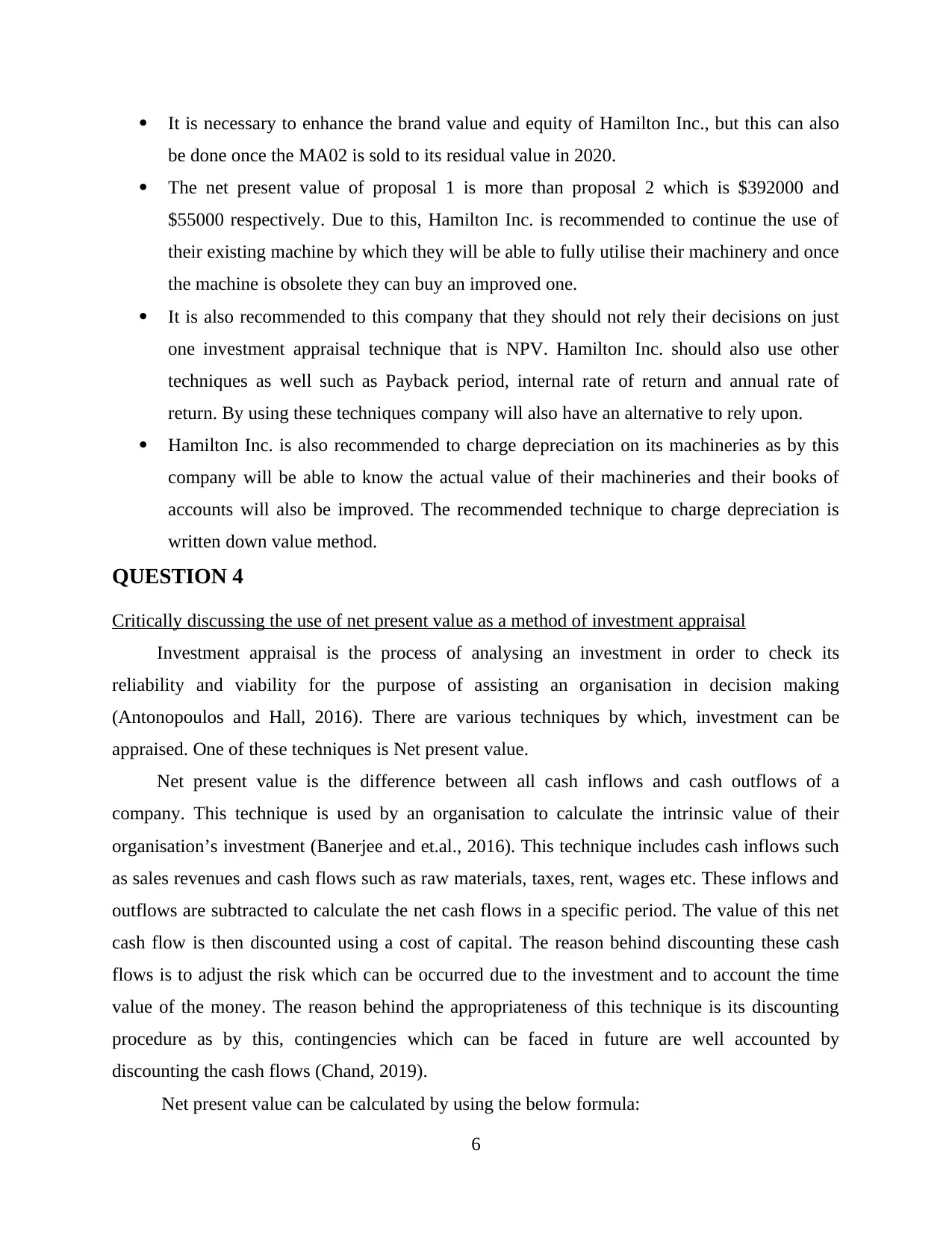
It is necessary to enhance the brand value and equity of Hamilton Inc., but this can also
be done once the MA02 is sold to its residual value in 2020.
The net present value of proposal 1 is more than proposal 2 which is $392000 and
$55000 respectively. Due to this, Hamilton Inc. is recommended to continue the use of
their existing machine by which they will be able to fully utilise their machinery and once
the machine is obsolete they can buy an improved one.
It is also recommended to this company that they should not rely their decisions on just
one investment appraisal technique that is NPV. Hamilton Inc. should also use other
techniques as well such as Payback period, internal rate of return and annual rate of
return. By using these techniques company will also have an alternative to rely upon.
Hamilton Inc. is also recommended to charge depreciation on its machineries as by this
company will be able to know the actual value of their machineries and their books of
accounts will also be improved. The recommended technique to charge depreciation is
written down value method.
QUESTION 4
Critically discussing the use of net present value as a method of investment appraisal
Investment appraisal is the process of analysing an investment in order to check its
reliability and viability for the purpose of assisting an organisation in decision making
(Antonopoulos and Hall, 2016). There are various techniques by which, investment can be
appraised. One of these techniques is Net present value.
Net present value is the difference between all cash inflows and cash outflows of a
company. This technique is used by an organisation to calculate the intrinsic value of their
organisation’s investment (Banerjee and et.al., 2016). This technique includes cash inflows such
as sales revenues and cash flows such as raw materials, taxes, rent, wages etc. These inflows and
outflows are subtracted to calculate the net cash flows in a specific period. The value of this net
cash flow is then discounted using a cost of capital. The reason behind discounting these cash
flows is to adjust the risk which can be occurred due to the investment and to account the time
value of the money. The reason behind the appropriateness of this technique is its discounting
procedure as by this, contingencies which can be faced in future are well accounted by
discounting the cash flows (Chand, 2019).
Net present value can be calculated by using the below formula:
6
be done once the MA02 is sold to its residual value in 2020.
The net present value of proposal 1 is more than proposal 2 which is $392000 and
$55000 respectively. Due to this, Hamilton Inc. is recommended to continue the use of
their existing machine by which they will be able to fully utilise their machinery and once
the machine is obsolete they can buy an improved one.
It is also recommended to this company that they should not rely their decisions on just
one investment appraisal technique that is NPV. Hamilton Inc. should also use other
techniques as well such as Payback period, internal rate of return and annual rate of
return. By using these techniques company will also have an alternative to rely upon.
Hamilton Inc. is also recommended to charge depreciation on its machineries as by this
company will be able to know the actual value of their machineries and their books of
accounts will also be improved. The recommended technique to charge depreciation is
written down value method.
QUESTION 4
Critically discussing the use of net present value as a method of investment appraisal
Investment appraisal is the process of analysing an investment in order to check its
reliability and viability for the purpose of assisting an organisation in decision making
(Antonopoulos and Hall, 2016). There are various techniques by which, investment can be
appraised. One of these techniques is Net present value.
Net present value is the difference between all cash inflows and cash outflows of a
company. This technique is used by an organisation to calculate the intrinsic value of their
organisation’s investment (Banerjee and et.al., 2016). This technique includes cash inflows such
as sales revenues and cash flows such as raw materials, taxes, rent, wages etc. These inflows and
outflows are subtracted to calculate the net cash flows in a specific period. The value of this net
cash flow is then discounted using a cost of capital. The reason behind discounting these cash
flows is to adjust the risk which can be occurred due to the investment and to account the time
value of the money. The reason behind the appropriateness of this technique is its discounting
procedure as by this, contingencies which can be faced in future are well accounted by
discounting the cash flows (Chand, 2019).
Net present value can be calculated by using the below formula:
6
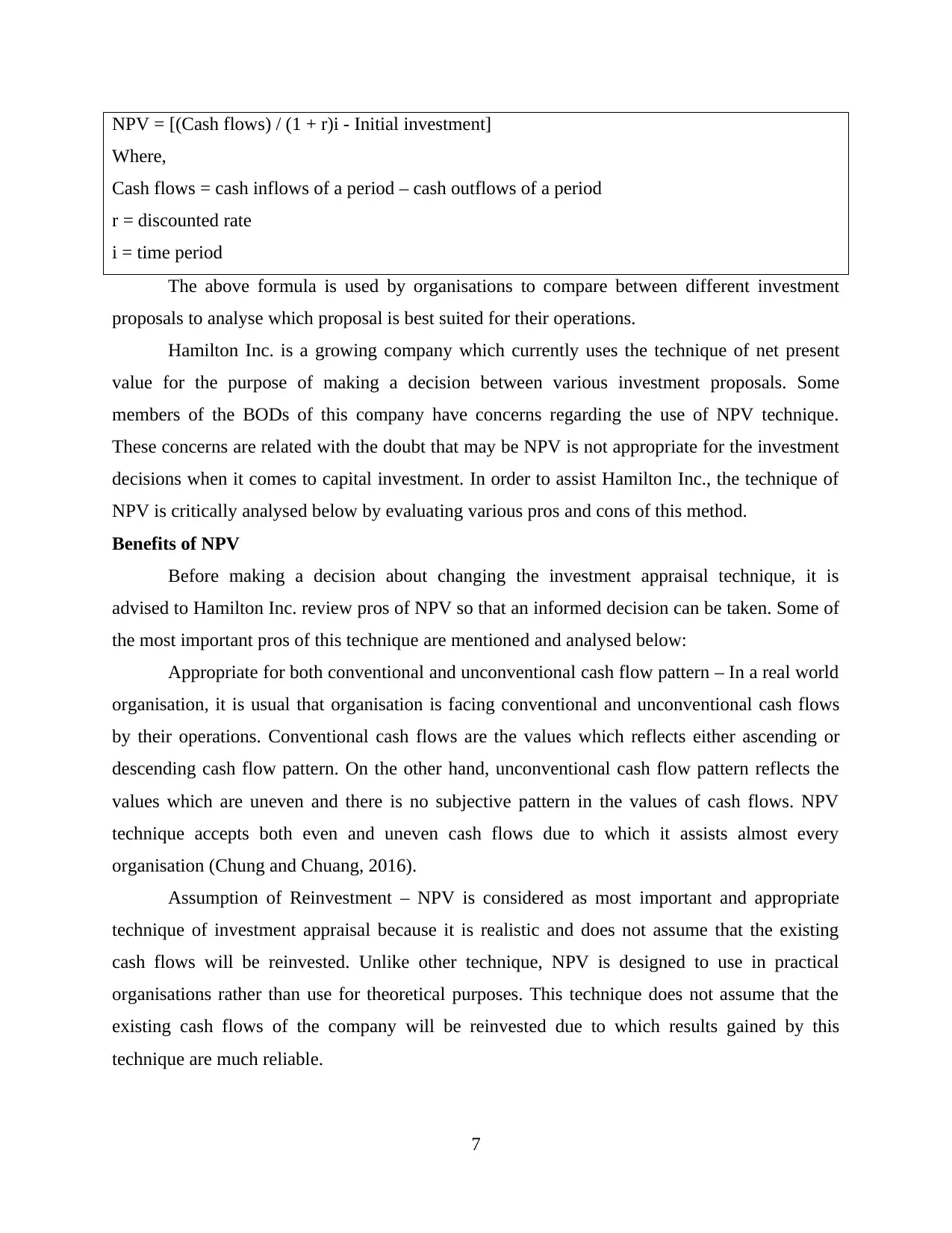
NPV = [(Cash flows) / (1 + r)i - Initial investment]
Where,
Cash flows = cash inflows of a period – cash outflows of a period
r = discounted rate
i = time period
The above formula is used by organisations to compare between different investment
proposals to analyse which proposal is best suited for their operations.
Hamilton Inc. is a growing company which currently uses the technique of net present
value for the purpose of making a decision between various investment proposals. Some
members of the BODs of this company have concerns regarding the use of NPV technique.
These concerns are related with the doubt that may be NPV is not appropriate for the investment
decisions when it comes to capital investment. In order to assist Hamilton Inc., the technique of
NPV is critically analysed below by evaluating various pros and cons of this method.
Benefits of NPV
Before making a decision about changing the investment appraisal technique, it is
advised to Hamilton Inc. review pros of NPV so that an informed decision can be taken. Some of
the most important pros of this technique are mentioned and analysed below:
Appropriate for both conventional and unconventional cash flow pattern – In a real world
organisation, it is usual that organisation is facing conventional and unconventional cash flows
by their operations. Conventional cash flows are the values which reflects either ascending or
descending cash flow pattern. On the other hand, unconventional cash flow pattern reflects the
values which are uneven and there is no subjective pattern in the values of cash flows. NPV
technique accepts both even and uneven cash flows due to which it assists almost every
organisation (Chung and Chuang, 2016).
Assumption of Reinvestment – NPV is considered as most important and appropriate
technique of investment appraisal because it is realistic and does not assume that the existing
cash flows will be reinvested. Unlike other technique, NPV is designed to use in practical
organisations rather than use for theoretical purposes. This technique does not assume that the
existing cash flows of the company will be reinvested due to which results gained by this
technique are much reliable.
7
Where,
Cash flows = cash inflows of a period – cash outflows of a period
r = discounted rate
i = time period
The above formula is used by organisations to compare between different investment
proposals to analyse which proposal is best suited for their operations.
Hamilton Inc. is a growing company which currently uses the technique of net present
value for the purpose of making a decision between various investment proposals. Some
members of the BODs of this company have concerns regarding the use of NPV technique.
These concerns are related with the doubt that may be NPV is not appropriate for the investment
decisions when it comes to capital investment. In order to assist Hamilton Inc., the technique of
NPV is critically analysed below by evaluating various pros and cons of this method.
Benefits of NPV
Before making a decision about changing the investment appraisal technique, it is
advised to Hamilton Inc. review pros of NPV so that an informed decision can be taken. Some of
the most important pros of this technique are mentioned and analysed below:
Appropriate for both conventional and unconventional cash flow pattern – In a real world
organisation, it is usual that organisation is facing conventional and unconventional cash flows
by their operations. Conventional cash flows are the values which reflects either ascending or
descending cash flow pattern. On the other hand, unconventional cash flow pattern reflects the
values which are uneven and there is no subjective pattern in the values of cash flows. NPV
technique accepts both even and uneven cash flows due to which it assists almost every
organisation (Chung and Chuang, 2016).
Assumption of Reinvestment – NPV is considered as most important and appropriate
technique of investment appraisal because it is realistic and does not assume that the existing
cash flows will be reinvested. Unlike other technique, NPV is designed to use in practical
organisations rather than use for theoretical purposes. This technique does not assume that the
existing cash flows of the company will be reinvested due to which results gained by this
technique are much reliable.
7
⊘ This is a preview!⊘
Do you want full access?
Subscribe today to unlock all pages.

Trusted by 1+ million students worldwide
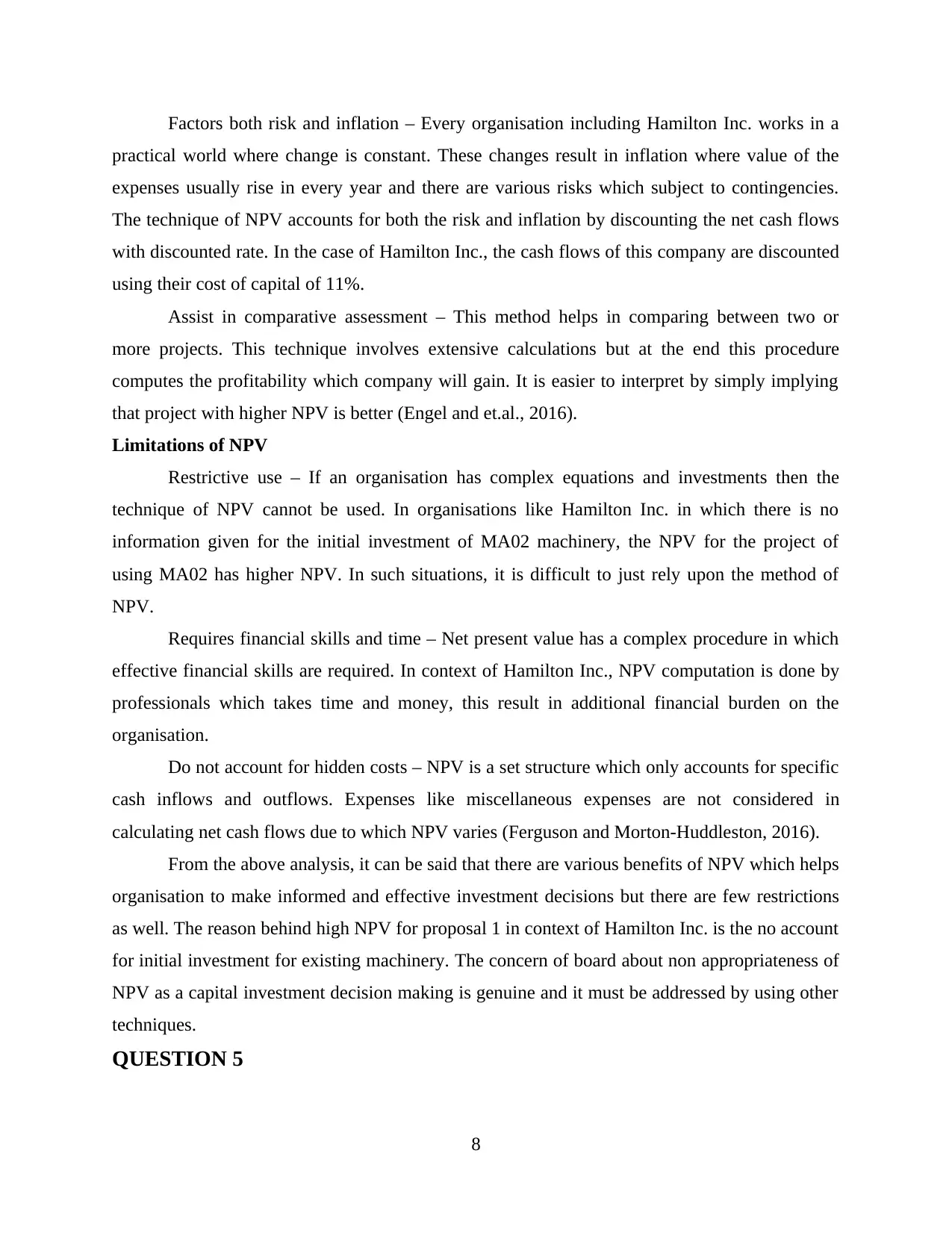
Factors both risk and inflation – Every organisation including Hamilton Inc. works in a
practical world where change is constant. These changes result in inflation where value of the
expenses usually rise in every year and there are various risks which subject to contingencies.
The technique of NPV accounts for both the risk and inflation by discounting the net cash flows
with discounted rate. In the case of Hamilton Inc., the cash flows of this company are discounted
using their cost of capital of 11%.
Assist in comparative assessment – This method helps in comparing between two or
more projects. This technique involves extensive calculations but at the end this procedure
computes the profitability which company will gain. It is easier to interpret by simply implying
that project with higher NPV is better (Engel and et.al., 2016).
Limitations of NPV
Restrictive use – If an organisation has complex equations and investments then the
technique of NPV cannot be used. In organisations like Hamilton Inc. in which there is no
information given for the initial investment of MA02 machinery, the NPV for the project of
using MA02 has higher NPV. In such situations, it is difficult to just rely upon the method of
NPV.
Requires financial skills and time – Net present value has a complex procedure in which
effective financial skills are required. In context of Hamilton Inc., NPV computation is done by
professionals which takes time and money, this result in additional financial burden on the
organisation.
Do not account for hidden costs – NPV is a set structure which only accounts for specific
cash inflows and outflows. Expenses like miscellaneous expenses are not considered in
calculating net cash flows due to which NPV varies (Ferguson and Morton-Huddleston, 2016).
From the above analysis, it can be said that there are various benefits of NPV which helps
organisation to make informed and effective investment decisions but there are few restrictions
as well. The reason behind high NPV for proposal 1 in context of Hamilton Inc. is the no account
for initial investment for existing machinery. The concern of board about non appropriateness of
NPV as a capital investment decision making is genuine and it must be addressed by using other
techniques.
QUESTION 5
8
practical world where change is constant. These changes result in inflation where value of the
expenses usually rise in every year and there are various risks which subject to contingencies.
The technique of NPV accounts for both the risk and inflation by discounting the net cash flows
with discounted rate. In the case of Hamilton Inc., the cash flows of this company are discounted
using their cost of capital of 11%.
Assist in comparative assessment – This method helps in comparing between two or
more projects. This technique involves extensive calculations but at the end this procedure
computes the profitability which company will gain. It is easier to interpret by simply implying
that project with higher NPV is better (Engel and et.al., 2016).
Limitations of NPV
Restrictive use – If an organisation has complex equations and investments then the
technique of NPV cannot be used. In organisations like Hamilton Inc. in which there is no
information given for the initial investment of MA02 machinery, the NPV for the project of
using MA02 has higher NPV. In such situations, it is difficult to just rely upon the method of
NPV.
Requires financial skills and time – Net present value has a complex procedure in which
effective financial skills are required. In context of Hamilton Inc., NPV computation is done by
professionals which takes time and money, this result in additional financial burden on the
organisation.
Do not account for hidden costs – NPV is a set structure which only accounts for specific
cash inflows and outflows. Expenses like miscellaneous expenses are not considered in
calculating net cash flows due to which NPV varies (Ferguson and Morton-Huddleston, 2016).
From the above analysis, it can be said that there are various benefits of NPV which helps
organisation to make informed and effective investment decisions but there are few restrictions
as well. The reason behind high NPV for proposal 1 in context of Hamilton Inc. is the no account
for initial investment for existing machinery. The concern of board about non appropriateness of
NPV as a capital investment decision making is genuine and it must be addressed by using other
techniques.
QUESTION 5
8
Paraphrase This Document
Need a fresh take? Get an instant paraphrase of this document with our AI Paraphraser
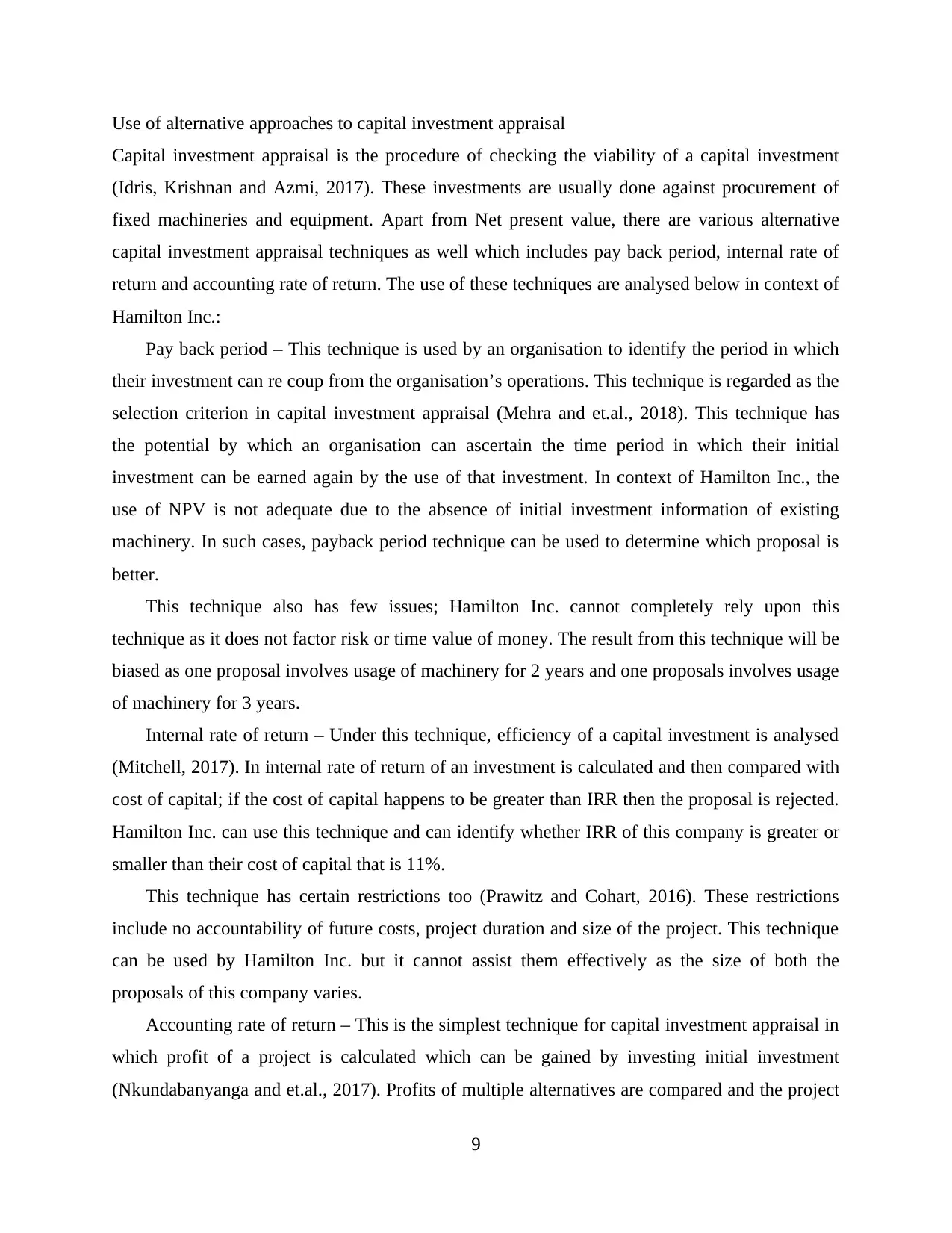
Use of alternative approaches to capital investment appraisal
Capital investment appraisal is the procedure of checking the viability of a capital investment
(Idris, Krishnan and Azmi, 2017). These investments are usually done against procurement of
fixed machineries and equipment. Apart from Net present value, there are various alternative
capital investment appraisal techniques as well which includes pay back period, internal rate of
return and accounting rate of return. The use of these techniques are analysed below in context of
Hamilton Inc.:
Pay back period – This technique is used by an organisation to identify the period in which
their investment can re coup from the organisation’s operations. This technique is regarded as the
selection criterion in capital investment appraisal (Mehra and et.al., 2018). This technique has
the potential by which an organisation can ascertain the time period in which their initial
investment can be earned again by the use of that investment. In context of Hamilton Inc., the
use of NPV is not adequate due to the absence of initial investment information of existing
machinery. In such cases, payback period technique can be used to determine which proposal is
better.
This technique also has few issues; Hamilton Inc. cannot completely rely upon this
technique as it does not factor risk or time value of money. The result from this technique will be
biased as one proposal involves usage of machinery for 2 years and one proposals involves usage
of machinery for 3 years.
Internal rate of return – Under this technique, efficiency of a capital investment is analysed
(Mitchell, 2017). In internal rate of return of an investment is calculated and then compared with
cost of capital; if the cost of capital happens to be greater than IRR then the proposal is rejected.
Hamilton Inc. can use this technique and can identify whether IRR of this company is greater or
smaller than their cost of capital that is 11%.
This technique has certain restrictions too (Prawitz and Cohart, 2016). These restrictions
include no accountability of future costs, project duration and size of the project. This technique
can be used by Hamilton Inc. but it cannot assist them effectively as the size of both the
proposals of this company varies.
Accounting rate of return – This is the simplest technique for capital investment appraisal in
which profit of a project is calculated which can be gained by investing initial investment
(Nkundabanyanga and et.al., 2017). Profits of multiple alternatives are compared and the project
9
Capital investment appraisal is the procedure of checking the viability of a capital investment
(Idris, Krishnan and Azmi, 2017). These investments are usually done against procurement of
fixed machineries and equipment. Apart from Net present value, there are various alternative
capital investment appraisal techniques as well which includes pay back period, internal rate of
return and accounting rate of return. The use of these techniques are analysed below in context of
Hamilton Inc.:
Pay back period – This technique is used by an organisation to identify the period in which
their investment can re coup from the organisation’s operations. This technique is regarded as the
selection criterion in capital investment appraisal (Mehra and et.al., 2018). This technique has
the potential by which an organisation can ascertain the time period in which their initial
investment can be earned again by the use of that investment. In context of Hamilton Inc., the
use of NPV is not adequate due to the absence of initial investment information of existing
machinery. In such cases, payback period technique can be used to determine which proposal is
better.
This technique also has few issues; Hamilton Inc. cannot completely rely upon this
technique as it does not factor risk or time value of money. The result from this technique will be
biased as one proposal involves usage of machinery for 2 years and one proposals involves usage
of machinery for 3 years.
Internal rate of return – Under this technique, efficiency of a capital investment is analysed
(Mitchell, 2017). In internal rate of return of an investment is calculated and then compared with
cost of capital; if the cost of capital happens to be greater than IRR then the proposal is rejected.
Hamilton Inc. can use this technique and can identify whether IRR of this company is greater or
smaller than their cost of capital that is 11%.
This technique has certain restrictions too (Prawitz and Cohart, 2016). These restrictions
include no accountability of future costs, project duration and size of the project. This technique
can be used by Hamilton Inc. but it cannot assist them effectively as the size of both the
proposals of this company varies.
Accounting rate of return – This is the simplest technique for capital investment appraisal in
which profit of a project is calculated which can be gained by investing initial investment
(Nkundabanyanga and et.al., 2017). Profits of multiple alternatives are compared and the project
9
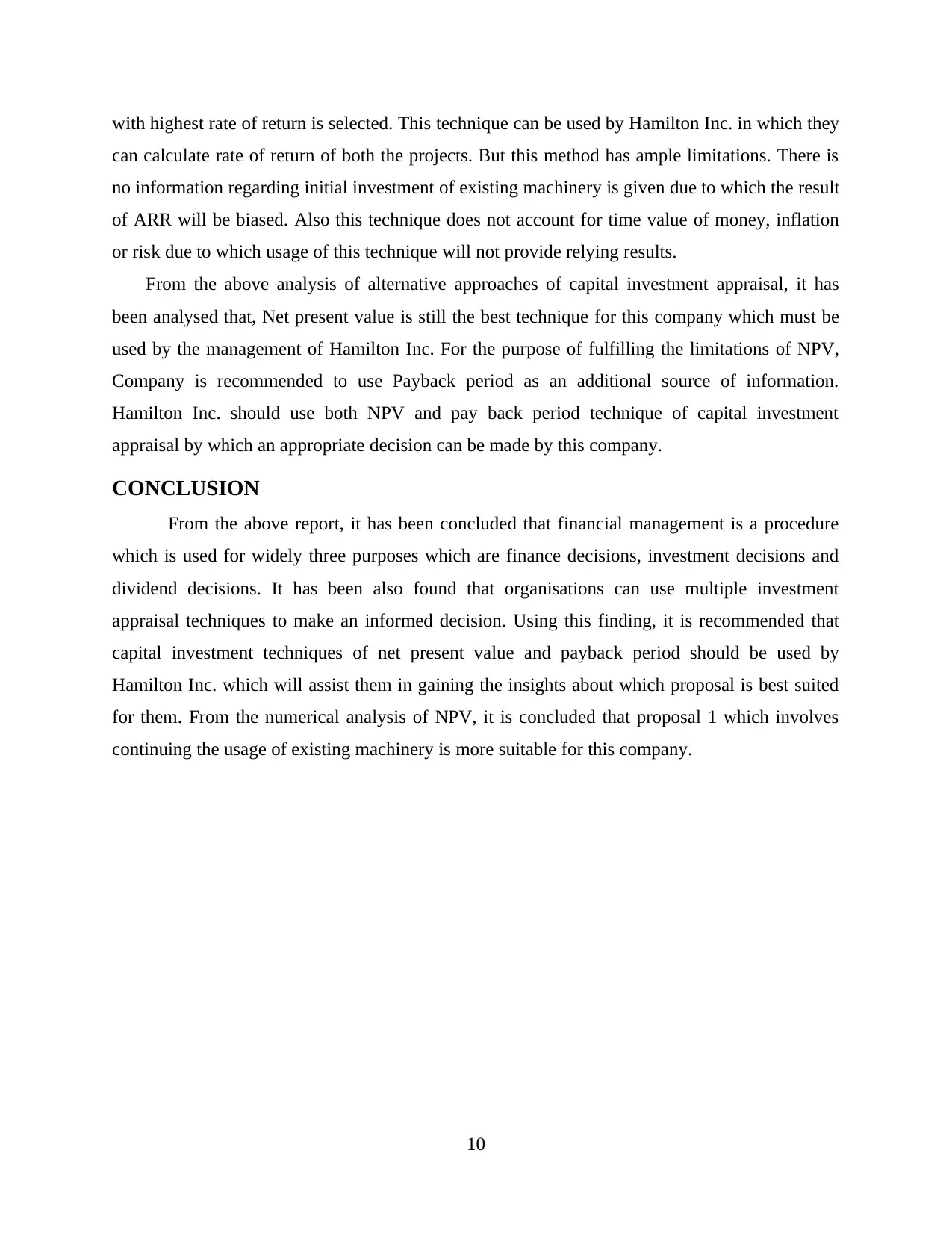
with highest rate of return is selected. This technique can be used by Hamilton Inc. in which they
can calculate rate of return of both the projects. But this method has ample limitations. There is
no information regarding initial investment of existing machinery is given due to which the result
of ARR will be biased. Also this technique does not account for time value of money, inflation
or risk due to which usage of this technique will not provide relying results.
From the above analysis of alternative approaches of capital investment appraisal, it has
been analysed that, Net present value is still the best technique for this company which must be
used by the management of Hamilton Inc. For the purpose of fulfilling the limitations of NPV,
Company is recommended to use Payback period as an additional source of information.
Hamilton Inc. should use both NPV and pay back period technique of capital investment
appraisal by which an appropriate decision can be made by this company.
CONCLUSION
From the above report, it has been concluded that financial management is a procedure
which is used for widely three purposes which are finance decisions, investment decisions and
dividend decisions. It has been also found that organisations can use multiple investment
appraisal techniques to make an informed decision. Using this finding, it is recommended that
capital investment techniques of net present value and payback period should be used by
Hamilton Inc. which will assist them in gaining the insights about which proposal is best suited
for them. From the numerical analysis of NPV, it is concluded that proposal 1 which involves
continuing the usage of existing machinery is more suitable for this company.
10
can calculate rate of return of both the projects. But this method has ample limitations. There is
no information regarding initial investment of existing machinery is given due to which the result
of ARR will be biased. Also this technique does not account for time value of money, inflation
or risk due to which usage of this technique will not provide relying results.
From the above analysis of alternative approaches of capital investment appraisal, it has
been analysed that, Net present value is still the best technique for this company which must be
used by the management of Hamilton Inc. For the purpose of fulfilling the limitations of NPV,
Company is recommended to use Payback period as an additional source of information.
Hamilton Inc. should use both NPV and pay back period technique of capital investment
appraisal by which an appropriate decision can be made by this company.
CONCLUSION
From the above report, it has been concluded that financial management is a procedure
which is used for widely three purposes which are finance decisions, investment decisions and
dividend decisions. It has been also found that organisations can use multiple investment
appraisal techniques to make an informed decision. Using this finding, it is recommended that
capital investment techniques of net present value and payback period should be used by
Hamilton Inc. which will assist them in gaining the insights about which proposal is best suited
for them. From the numerical analysis of NPV, it is concluded that proposal 1 which involves
continuing the usage of existing machinery is more suitable for this company.
10
⊘ This is a preview!⊘
Do you want full access?
Subscribe today to unlock all pages.

Trusted by 1+ million students worldwide
1 out of 13
Related Documents
Your All-in-One AI-Powered Toolkit for Academic Success.
+13062052269
info@desklib.com
Available 24*7 on WhatsApp / Email
![[object Object]](/_next/static/media/star-bottom.7253800d.svg)
Unlock your academic potential
Copyright © 2020–2025 A2Z Services. All Rights Reserved. Developed and managed by ZUCOL.





